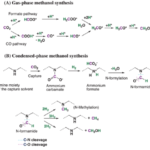新しい研究により、沿岸の生息地は十分な土砂がある場合にのみ繁栄することが明らかになりました。 New research shows that coastal habitats can thrive—but only if there’s enough sediment
2023-01-23 マサチューセッツ大学アマースト校
 The Portland Gale of 1898 moved the inlet of the North-South Rivers Estuary approximately three-and-a-half miles northwest of its previous location. Credit: UMass Amherst
The Portland Gale of 1898 moved the inlet of the North-South Rivers Estuary approximately three-and-a-half miles northwest of its previous location. Credit: UMass Amherst
◆マサチューセッツ大学アマースト校の地球・地理・気候科学研究教授ブライアン・イエレンが率いる研究チームは、このほどJournal of Geophysical Research誌で発表しました。この発表によると、塩性湿地は急激な海面上昇の影響を受ける重要な生息地ですが、実際には水位が上昇しても生育する可能性があることがわかりました。塩湿地が崩壊するか繁栄するかを決定する重要な要因は、水ではなく土砂にあるのです。
◆ポートランドゲイルは、マサチューセッツ州沿岸をハリケーン級の強風と大量の雨、高潮で襲い、ボストンの南に位置するシチュエートのノースサウスリバー河口は、この高潮によって大きく変化した。
◆塩湿地は渡り鳥や稚魚の生息地として重要なだけでなく、海岸線を嵐の被害から守り、流出水から汚染物質をろ過するなど、多くの重要な生態系サービスを提供しているのです。また、サイテュライトの湿地が突然氾濫すれば、致命的な打撃を受けると思われるかもしれませんが、そうではありません。
◆”塩湿地は3つのものからできています “と彼は続けます。”水、植物、土砂 “です。研究チームは、ノースリバー河口付近の海岸に接する高い海岸崖が、ゆっくりと海に浸食されることで豊富な土砂を供給し、ポートランドゲイルのような壊滅的な状況下でも、塩湿地が跳ね返って環境の変化に適応できるのだと仮説を立てています。
◆イエレンは、浚渫や沿岸航行の中止やすべてのダムの撤去を主張しているわけではなく、浚渫が必要な場合は、影響を受ける河口系に補償的に土砂を再注入する必要があるとすぐに指摘しています。
◆米国地質調査所と内務省の北東部気候適応科学センターの支援を受けたこの研究は、ほんの始まりに過ぎない。イエレンたちはすでにニューイングランド全州の12人の公的関係者とチームを組み、気候変動がニューイングランドの海岸線にもたらすリスクに立ち向かう最善の方法をさらに調査しているところだ。
<関連情報>
- https://www.umass.edu/news/article/key-weathering-rapid-sea-level-rise-may-lie-massachusetts-salt-marsh
- https://agupubs.onlinelibrary.wiley.com/doi/10.1029/2022JF006815
潮流調節装置による潮位上昇に対する塩性湿原の応答 Salt Marsh Response to Inlet Switch-Induced Increases in Tidal Inundation
Brian Yellen, Jonathan D. Woodruff, Hannah E. Baranes, Simon E. Engelhart, W. Rockwell Geywer, Noa Randall, Frances R. Griswold
Journal of Geophysical Research Published: 22 December 2022
DOI:https://doi.org/10.1029/2022JF006815
Abstract
There is widespread concern that rapidly rising sea levels may drown salt marshes by exceeding the rate at which these important ecosystems can build elevation. A significant fraction of marshes reside within backbarrier estuaries, yet little attention has been paid to how changes in inlet geometry influences estuarine tides and marshes. In 1898, a coastal storm eroded a new inlet through the barrier beach that fronts the North-South Rivers Estuary in Massachusetts, USA. The new inlet shortened the North River by 5.6 km and lengthened the South River channel by the same amount. Modern measurements of tidal attenuation suggest that channel shortening abruptly increased mean high tide along the North River by at least 30 cm. Foraminifera communities within North River marsh sediments indicated an environmental change from infrequent to frequent inundation at the time of the 1898 switch in inlet location, which supports this hypothesis. Increased mineral sediment deposition after the inlet switch played a dominant role in allowing marshes along the North River channel to adjust to greater inundation. Following the inlet switch, sediment accreted in North River marshes at 2–5 times the rate of sea level rise (SLR). The North River channel widened by an average of 18% relative to pre-1898 conditions to accommodate the increased tidal prism. The role of mineral sediment accretion in making this marsh resilient to an abrupt increase in inundation depth highlights the importance of maintaining adequate sediment supplies in coastal regions as SLR accelerates.
Key Points
- Inlet and barrier dynamics can have first order controls on tidal propagation and impacts to marshes
- Deposition rates three to five times the rate of sea level rise (SLR) allowed for continued marsh resilience
- Minerogenic sediment supply allowed for marsh resilience under rapid rates of effective SLR
Plain Language Summary
Salt marshes form along sheltered coastlines, incorporating mud and dead roots atop a grassy platform at about the elevation of high tide. It is unclear whether marshes will build their platforms fast enough to keep up with expected increases in sea level. In 1898, a coastal storm eroded a new opening in a beach, behind which a salt marsh extends inland along two tidal channels. The new inlet shortened the distance from the open ocean to parts of the salt marsh, causing high tides that flood the salt marsh to increase more than 30 cm. We considered this “natural experiment” in increased tidal flooding to understand how other marshes might survive rapid sea level rise (SLR). Sediment core samples from the marsh showed that higher tides after the inlet switch resulted in lots of mineral sediment deposited on the marsh platform. This shows that mineral sediment is very important to salt marsh survival when sea level is rising fast. Increased tidal flow after the inlet switch eroded and widened channels. Some of that eroded channel bank sediment deposited atop the marsh, but most of the sediment that allowed the marsh to survive rapid SLR came from the ocean.



